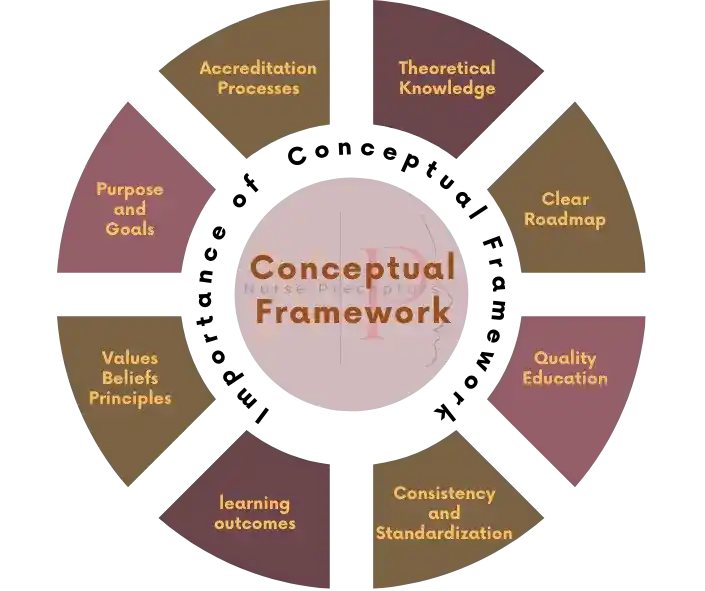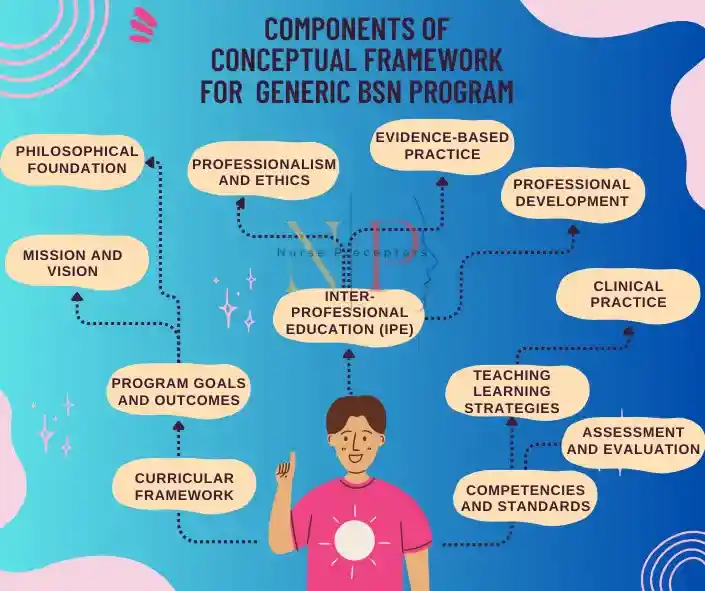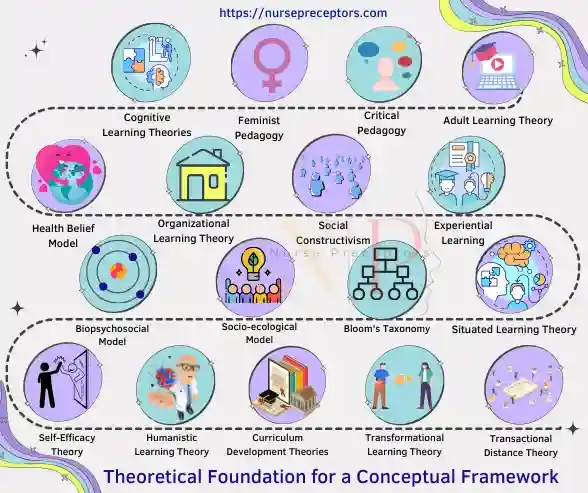What is the Model of Conceptual Framework for a Generic BSN Program?
The model of a conceptual framework for a generic Bachelor of Science in Nursing (BSN) program typically outlines the foundational principles, key concepts, and overarching structure that guide the curriculum and educational goals of the program. Specific theoretical frameworks may vary among institutions. You can read the full information about theoretical frameworks in the USA from our online trusted website Nurse Preceptors.
A conceptual framework integrates the theories, assumptions, beliefs, and concepts that underpin your research and displays them in a narrative, graphical, or pictorial fashion. It outlines the criteria for defining a research topic and identifying relevant, meaningful responses.
These frameworks provide a theoretical foundation and guide for nursing education, helping to shape the curriculum and ensure that students develop the necessary knowledge and skills to become competent nurses.
It’s important to note that specific programs may have variations in their theoretical domain framework based on the institution’s mission, goals, and educational philosophy.
Additionally, frameworks may be periodically revised to align with evolving healthcare trends, educational research, and accreditation requirements.
Importance of Conceptual Framework in a Generic BSN Program

The conceptual framework in a generic Bachelor of Science in Nursing program is paramount for several reasons. It serves as the foundational structure that guides the.
Here are some key reasons why a conceptual framework is important:
- It provides a clear roadmap for developing and organizing the BSN program. It serves as a foundational document that guides curriculum design, teaching strategies, and overall educational goals.
- It ensures that all students receive a high-quality education that prepares them for the complexities of modern healthcare.
- A conceptual framework also promotes consistency and standardization in the curriculum, ensuring that graduates possess the necessary knowledge and skills to provide safe and effective care to patients.
- It helps educators to establish clear learning outcomes, identify the necessary content areas, and design effective teaching strategies.
- It helps in defining the core values, beliefs, and principles that shape the education of future nurses. This foundation helps create a cohesive and consistent approach to nursing education.
- It clearly articulates the purpose and goals of the BSN program, providing a shared understanding among faculty, students, and stakeholders. This clarity helps maintain focus and coherence in the delivery of nursing education.
- It supports accreditation processes by demonstrating that the program is based on sound educational principles and meets professional standards. Having a well-defined conceptual framework contributes to the program’s credibility and quality assurance.
- It promotes the integration of theoretical knowledge with practical skills and clinical experiences. Helps students understand the relevance and application of theoretical concepts in real-world nursing practice.
In summary, a conceptual framework is essential for providing a solid foundation, maintaining coherence, and ensuring the ongoing success and relevance of a generic BSN program.
It serves as a unifying document that aligns the program with its mission, values, and overarching goals, fostering a purposeful and effective educational experience for aspiring nurses.
Key Components of Conceptual Framework for a Generic BSN Program

The specific elements may vary based on the institution and its goals, but here are some common components:
- Philosophical Foundation: The philosophical foundation defines the core beliefs and values of the nursing program. It articulates the program’s commitment to nursing as a profession and its role in healthcare.
- Mission and Vision: It clearly expresses the program’s mission and vision and outlines its purpose and aspirations in an academic setup for future nurses.
- Program Goals and Outcomes: This part of the conceptual framework outlines the main objectives of the BSN program, which include equipping graduates with the necessary skills for professional nursing practice, leadership positions, and continuous learning. It also assists in determining the specific learning outcomes that students should attain by the completion of the program.
- Curricular Framework: This component forms the structure of the curriculum, including core courses, clinical experiences, and any specialized tracks or concentrations. It highlights the integration of theory and practice in nursing education.
- Competencies and Standards: This section consists of specifying the competencies and professional standards that students are expected to meet during the program. It is crucial to align the curriculum with national and international standards for nursing education and practice.
- Teaching and Learning Strategies: This part describes the pedagogical approaches to be used in the program, such as active learning, simulation, and clinical experiences. It emphasizes the use of evidence-based practice in teaching and learning.
- Assessment and Evaluation: This component defines the criteria to assess the students’ learning and program effectiveness. It highlights mechanisms for ongoing evaluation and improvement of the curriculum.
- Clinical Practice: This part addresses the role of clinical experiences in the program, including the types of settings and the integration of theory into practice. It emphasizes the importance of ethical and culturally competent nursing care.
- Interprofessional Education (IPE): It acknowledges the significance of collaboration with other healthcare professionals. It provides opportunities for students to learn from other students of different health professions.
- Professionalism and Ethics: This component emphasizes the development of professional values, ethics, and behaviors in nursing practice. It addresses the importance of cultural competence and sensitivity.
- Research and Evidence-Based Practice: This part integrates research and evidence-based practice in the curriculum to prepare graduates to advance nursing knowledge.
- Lifelong Learning and Professional Development: The conceptual framework aims to instill a lifelong commitment to learning and professional development among students.
By incorporating these key components into a conceptual framework, a BSN program can provide a solid foundation for nursing education that aligns with professional standards and prepares graduates for successful and ethical nursing practice.
Theoretical Foundation for a Conceptual Framework in Nursing Education

The theoretical foundations for a conceptual framework in nursing education provide the underlying principles and ideas that guide the development, implementation, and evaluation of educational programs for nursing students.
A solid theoretical foundation is essential for ensuring that nursing education is effective, relevant, and aligned with the goals of preparing competent and compassionate nurses.
Several theoretical perspectives and models can be considered in the development of a conceptual framework for nursing education. Here are several theoretical frameworks that can be applied to the development of a conceptual framework in nursing education:
When developing a conceptual framework in nursing education, it’s essential to consider the context, goals, and values of the educational program.
The integration of one or more of these theoretical frameworks can provide a solid foundation for creating a meaningful and effective nursing education framework.
Additionally, combining elements from various frameworks may be appropriate to capture the complexity of nursing education and practice.
How to Evaluate the Effectiveness of a Conceptual Framework in Nursing Education?
Evaluating the effectiveness of a conceptual framework in nursing education is crucial to ensuring that the educational goals are met and that students are adequately prepared for professional practice. Here are some steps and considerations for evaluating the effectiveness of a conceptual framework in nursing education:
- Define Clear Learning Outcomes: Clearly articulate the intended learning outcomes associated with the conceptual framework. These outcomes should align with the core concepts and principles identified in the framework.
- Establish Measurable Objectives: Develop specific, measurable, achievable, relevant, and time-bound (SMART) objectives for each learning outcome. It will provide a clear benchmark for assessing the effectiveness of the conceptual framework.
- Use Multiple Assessment Methods: Employ a variety of assessment methods to evaluate students’ understanding and application of the conceptual framework. It may include written exams, clinical assessments, simulations, case studies, and reflective assignments.
- Collect Baseline Data: Collect baseline data on student performance and knowledge before implementation of the conceptual framework. This will serve as a reference point for evaluating changes and improvements over time.
- Gather Feedback from Stakeholders: Obtain feedback from various stakeholders, including students, faculty, alumni, and employers. Surveys, focus groups, and interviews can be effective tools for collecting qualitative data on the perceived impact of the conceptual framework.
- Assess Clinical Competence: Evaluate students’ clinical competence and their ability to apply theoretical concepts in real-world healthcare settings. Clinical assessments should align with the framework’s principles and expectations.
- Monitor Graduates’ Success: Track the success of graduates in their professional careers. This may include passing rates on licensing exams, employment rates, and feedback from employers about the graduates’ preparedness and performance.
- Utilize Quantitative and Qualitative Data: Combine quantitative data (such as exam scores and graduation rates) with qualitative data (such as student narratives and faculty observations) to gain a comprehensive understanding of the effectiveness of the conceptual framework.
- Evaluate Faculty and Institutional Support: Assess the support provided by faculty and the institution in implementing the conceptual framework. Faculty development opportunities, resources, and institutional commitment play a significant role in the success of the framework.
- Conduct Periodic Reviews: Establish a regular schedule for reviewing and updating the conceptual framework based on ongoing evaluations. This ensures that the framework remains relevant and responsive to changes in nursing practice and education.
- Benchmark Against Accreditation Standards: Compare the outcomes of the nursing program against national and international accreditation standards. This helps ensure that the program meets industry benchmarks for nursing education.
- Consider Long-Term Impact: Assess the long-term impact of the conceptual framework on graduates’ professional development and contributions to the nursing profession. This may involve tracking alumni accomplishments and contributions to the field.
- Make Data-Driven Improvements: Use the evaluation data to make informed decisions and implement improvements to the conceptual framework, curriculum, and teaching methods. Continuous improvement is key to ensuring ongoing effectiveness.
- Document and Share Findings: Document evaluation findings and share them transparently with stakeholders. Communication of successes, challenges, and improvements fosters accountability and collaboration within the nursing education community.
By systematically evaluating the effectiveness of the conceptual framework in nursing education, educators can make informed decisions to enhance the learning experience and better prepare students for the challenges of professional nursing practice.
Conclusion: The Significance of a Well-Designed Conceptual Framework in a Generic BSN Program
A well-designed conceptual framework is essential in a generic BSN program, as it provides structure, promotes consistency, and facilitates learning.
It ensures that students receive a comprehensive education that prepares them for the complex and evolving healthcare environment. The framework promotes consistency, standardization, and clarity in the curriculum, facilitating the integration of knowledge from different disciplines and enabling students to develop a holistic understanding of nursing practice.
Additionally, the framework helps students establish a connection between theory and practice, allowing them to critically analyze real-world situations and provide evidence-based care.
References:
- 2011 Iste | Iste, Bello, Knowlton, & Chafin. (2007). Making the Connection: Moore’s Theory of Transactional Distance and Its Relevance to the Use of a Virtual Classroom in Postgraduate Online Teacher Education. 43(3), 187–209. https://files.eric.ed.gov/fulltext/EJ918904.pdf
- Bastable, S. (2019). Nurse as Educator: Principles of Teaching and Learning for Nursing Practice (5th ed.). Jones & Bartlett Learning.
- Berman, A., Snyder, S., & Frandsen, G. (2016). Kozier & Erb’s Fundamentals of Nursing: Concepts, Practice, and Process (10th ed.). Pearson.
- Bloom’s Taxonomy | Centre for Teaching Excellence. (n.d.). Uwaterloo.ca. https://uwaterloo.ca/centre-for-teaching-excellence/catalogs/tip-sheets/blooms-taxonomy#:~:text=Bloom
- Carey, M., & Forsyth, A. (2009). Self-Efficacy. American Psychological Association. https://www.apa.org/pi/aids/resources/education/self-efficacy#:~:text=Self%2Defficacy%20refers%20to%20an
- Centers for Disease Control and Prevention. (2022, January 18). The social-ecological model: A framework for prevention. Centers for Disease Control and Prevention; CDC. https://www.cdc.gov/violenceprevention/about/social-ecologicalmodel.html
- Cognitive Learning Theory. (n.d.). Www.wichita.edu. https://www.wichita.edu/services/mrc/OIR/Pedagogy/Theories/cognitive.php#:~:text=Cognitive%20Learning%20Theory%20asks%20us
- Communities of Practice (Lave and Wenger) – Learning Theories. (2014, July 16). Learning Theories. https://learning-theories.com/communities-of-practice-lave-and-wenger.html
- Communities of practice 1 A brief introduction. (n.d.). https://www.ohr.wisc.edu/cop/articles/communities_practice_intro_wenger.pdf
- Conceptual Framework Prepared By Lipika Mondal. (n.d.). https://aliah.ac.in/upload/media/08-04-20_1586341539.pdf
- Coşkun Yaşar, G., & Aslan, B. (2021). Curriculum Theory: A Review Study. Uluslararası Eğitim Programları ve Öğretim Çalışmaları Dergisi, 11(2), 237–260. https://doi.org/10.31704/ijocis.2021.012
- Critical Pedagogy. (n.d.). Sph.emory.edu. https://sph.emory.edu/rollins-tlc/teach-learn-principles/critical-pedagogy/index.html
- Delaune, S. C., & Ladner, P. K. (2002). Fundamentals of nursing: standards & practice. Delmar Thomson Learning.
- Diane, M. (2012). Religion, religious ethics, and nursing. Springer Pub. Co.
- Dolan, D. (2017). The New Nurse Educator, Second Edition Mastering Academe. New York Springer Publishing Company.
- Experiential Learning | Center for Teaching & Learning. (n.d.). Www.bu.edu. https://www.bu.edu/ctl/ctl_resource/experiential-learning/
- Gallagher, M. W. (2012). Self-Efficacy Theory – an overview | ScienceDirect Topics. Www.sciencedirect.com. https://www.sciencedirect.com/topics/psychology/self-efficacy-theory
- Hardie, M. (2021, October 10). Three Aspects of Health and Healing: The Biopsychosocial Model in Medicine. Department of Surgery. https://surgery.wustl.edu/three-aspects-of-health-and-healing-the-biopsychosocial-model/
- Jarre, A. (n.d.). Adult Learning Theory. 360Learning. https://360learning.com/guide/learning-theories/adult-learning-theory/
- Kurt, S. (2021, February 17). Situated Learning Theory. Educational Technology. https://educationaltechnology.net/situated-learning-theory/
- LaMorte, W. (2022). The Health Belief Model. Boston University School of Public Health. https://sphweb.bumc.bu.edu/otlt/MPH-Modules/SB/BehavioralChangeTheories/BehavioralChangeTheories2.html
- Leavitt, C. (2011). Running Head: THREE ORGANIZATIONAL LEARNING THEORIES 1 A Comparative Analysis of Three Unique Theories of Organizational Learning. https://files.eric.ed.gov/fulltext/ED523990.pdf
- Lowe, R. (2023). Biopsychosocial Model. Physiopedia. https://www.physio-pedia.com/Biopsychosocial_Model
- Masters, K. (2023). Role development in professional nursing practice (6th ed.). Jones & Bartlett Learning.
- Nursing Conceptual Model & Framework – University of Southern Indiana. (n.d.). Www.usi.edu. https://www.usi.edu/health/nursing/mission-philosophy/nursing-conceptual-model-framework
- Parker, M. E. (2001). Nursing theories and nursing practice. F.A. Davis.
- Patricia Ann Potter, Anne Griffin Perry, Stockert, P. A., & Hall, A. (2019). Essentials for nursing practice. Elsevier.
- Patronis, R. A. (2007). Nursing leadership and management: theories, processes, and practice. F.A. Davis Co.
- Philosophy and Conceptual Framework – Wallace Community College. (2020, May 16). https://www.wallace.edu/programs-training/health/associate-degree-nursing/philosophy-and-conceptual-framework/
- Rural Health Information Hub. (2018, April 30). The Health Belief Model. Ruralhealthinfo.org; Rural Health Information Hub. https://www.ruralhealthinfo.org/toolkits/health-promotion/2/theories-and-models/health-belief
- Scott, D. (2001). Curriculum Theory – an overview | ScienceDirect Topics. Www.sciencedirect.com. https://www.sciencedirect.com/topics/social-sciences/curriculum-theory
- University of Central Florida. (2019). Bloom’s Taxonomy. Ucf.edu. https://fctl.ucf.edu/teaching-resources/course-design/blooms-taxonomy/
- University of Florida. (2022). Kolb’s four stages of learning. Citt.ufl.edu. https://citt.ufl.edu/resources/the-learning-process/types-of-learners/kolbs-four-stages-of-learning/
- Western Governors University. (2020, July 17). What Is The Transformative Learning Theory. Western Governors University. https://www.wgu.edu/blog/what-transformative-learning-theory2007.html
- Western Governors University. (2020, July 21). What Is Humanistic Learning Theory in Education? Western Governors University. https://www.wgu.edu/blog/what-humanistic-learning-theory-education2007.html
- Western Governors University. (2020, May 27). What is constructivism? Western Governors University. https://www.wgu.edu/blog/what-constructivism2005.html